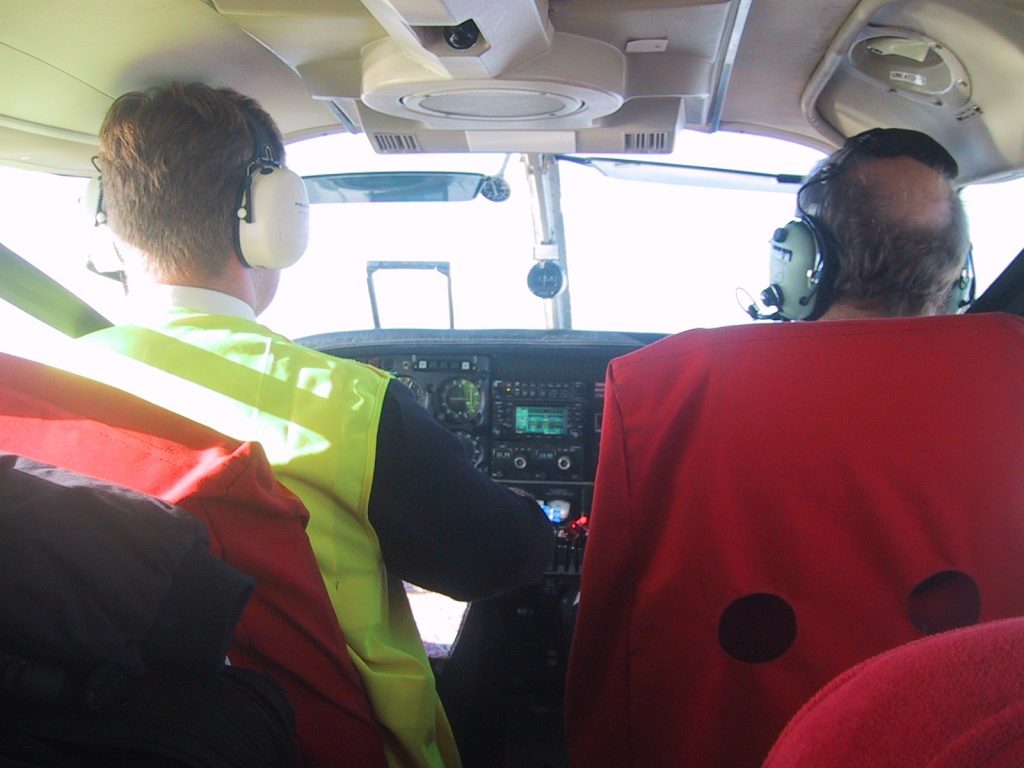My student Rick had been looking forward to this long cross-country flight, part of his commercial pilot’s licence (CPL) training. Quite the stickler for detailed planning, all of his paperwork was immaculately prepared, legible, and well organised in the cockpit. His plan called for a cruising altitude of 5,000 feet. We were climbing to that height and he had just checked in with the en-route controller.

Mind you, we weren’t technically being ‘controlled’ at that moment, since we were flying in Class G airspace, and would be doing so for most of the journey. That was reflected in the ATC response “no known traffic to affect your flight, remain clear of controlled airspace”. It seemed we had the entire skies to ourselves on this crisp morning.
Knowing Rick’s tendency to exactitude in his flying, I thought I would amuse myself (and challenge him) with a very specific instruction. “OK Rick, stop climb at altitude 4,352 feet. Maintain that level within plus or minus 1 foot.” He looked at me incredulously for a moment, guffawing a little, as if to say come on, let’s be serious. I told him to give it a shot. He focused again on his flying and I could almost see his thought processes at work. The marks on the altimeter display represent divisions of 20 feet for the ‘hundreds’ pointer, so at least, he commented, we could start by getting close to that. Sure enough, soon he had levelled off at 4,260 feet, and on this calm day in perfect weather he was well able, with subtle pressures on the wheel and tiny adjustments of trim, to maintain the needle exactly on the mark. “Right, now we will go halfway between the marks, to get to 4,350….” he muttered. He was warming to the task. Having established our height at that intermediate point, he put an infinitesimally small back pressure on the wheel to nudge it up ever so slightly, and concentrated on keeping it steady in that position. It was a close to 4,352 as you could discern. After a minute of steady flight he looked across the cockpit, beaming. I requested him to keep us at this level, within a foot either way, as long as he could, while (as is required when flying under visual flight rules) keeping a keen watch for other traffic. Having trimmed the aeroplane perfectly for level flight, it wasn’t too difficult for him to manage the task. I suggested that he only look at the altimeter when he sensed bodily that we had climbed or descended, by no matter how small an increment. We cruised for a long period at this rather silly target altitude, without departing more than ten feet or so from it.
Maintenance of altitude is a skill taught in our very first flying lessons, which we can sometimes take for granted too easily, once we feel we have mastered the required techniques. But as any instructor or examiner will tell you, students, and even test candidates, can often be observed flying at anything but their assigned height. They may achieve it for a few seconds, but soon their attention wanders and the needle’s excursions recommence. Eventually the discrepancy is noticed, and a large (sometimes over-large) correction is made in a slight panic. But shortly the needle will start its wandering again. This is often the occasion for another remarkable phenomenon, what we might designate the ‘level at anything but the correct altitude’ syndrome. It occurs when you assign an altitude of, say, 3000 feet for your student to cruise at, and indeed they fly perfectly level for mile after mile, but at 2,700, 2,800, 3,100….. indeed any altitude except the one they are supposed to be at! It’s as if a hidden magnet pushes the indicator away from their intended height, no matter how hard they try. It presents an opportunity to demonstrate that correct trimming will do most of the work for you, but you must confirm by a periodic scan of your instruments to make sure you’re on target at the intended altitude.
Rick, happy with his performance at our very precise chosen height, now volunteered that perhaps we could try the same with our direction. “Go for it”, was my immediate response, “fly within one degree of your planned heading.” I suggested that instead of twisting and turning the aeroplane and focusing on the compass and direction indicator in front of him, that he just concentrate on keeping the wings as level as possible once correctly established, and do most of his looking outside the cockpit. He did that, reacting similarly with the tiniest corrections the moment he observed or felt a wing drop, even by an inch. Our compass remained rock steady for long periods, within a degree or two, at most.
When fundamental skills such as holding altitude and heading are not fully internalised during early flight training, it is often because of a rush, on the part of students and sometimes the instructor, to ‘move on’ to the more exciting bits of the syllabus, on the assumption that the basics have been learned after a few quick exposures. But that is not always the case. What can seem effortless to one student can present difficulty for another, and it should be accepted that we can learn at different rates and levels of retention. If we progress past the basics without having absorbed them profoundly, it can diminish the precision of our flying over a very long term. These core skills are akin to the scales and other exercises required to be practiced by serious music students. Unexciting and rigorous as they may be, they form the bedrock of our chosen vocation, whether as concert pianist or air pilot.
After our flight Rick said he would never believe again that holding altitude within the required test tolerances should present any great difficulty. Having accepted and met the challenge of flying within a foot, or a degree or two, the standard flight test tolerances of 150 or 100 feet or ten or five degrees now seemed to be impossibly generous, over-large margins to him. Over the next few lessons during his training course I noticed that he significantly reduced his ‘personal minimums’, the variances from ideal flight he was prepared to tolerate in himself, in a number of other aspects of his flying. Even the roughest-looking club aeroplane is, by any standard, an example of precision engineering which can be steered and coaxed through the air with remarkable accuracy, when there exists sufficient will and attention by its pilot.
If we hold ourselves to standards far in excess of the minimum requirements, then, just as a broken old piano can still sound marvellous at the hands of a skilled player, we will find our aircraft responding with an impeccably precise flightpath. See you at 4,352 feet!







